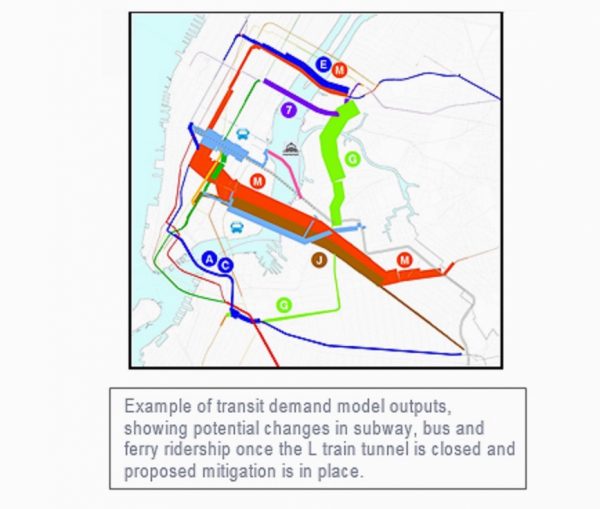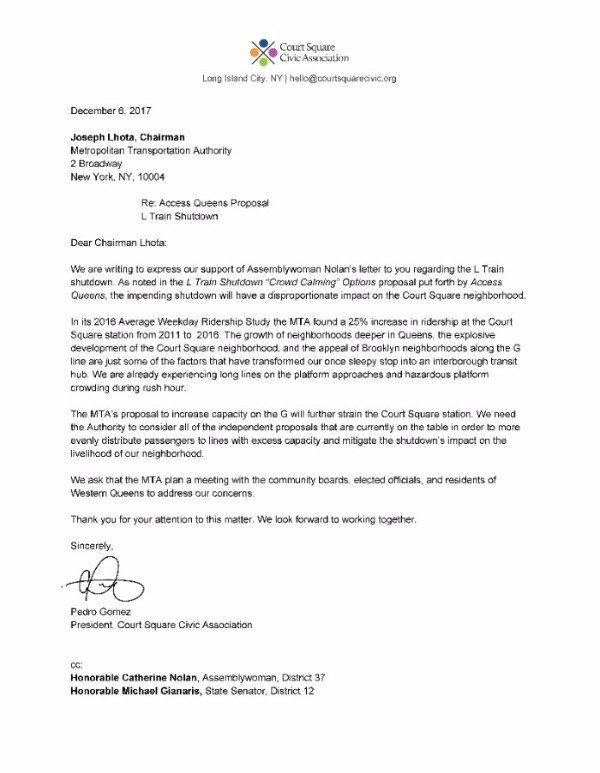
Court Square (Access Queens)
Dec. 11, 2017 By Nathaly Pesantez
L train shutdown woes are spilling over into Long Island City, where local leaders are demanding that the city develop a plan to reduce the impact of the thousands of L train riders expected to take the G up to the Manhattan-connecting Court Square after the L train shuts down in 2019.
The Court Square Civic Association urged MTA Chairman Joseph Lhota to protect Long Island City’s already-crowded Court Square station from the extra riders that would travel there once the L train tunnel connecting Williamsburg to Manhattan closes for Sandy-related repairs in 2019.

Transit Demand Model (MTA)
The G train, one of four train lines that go through Court Square, will be increasing its capacity by doubling in length to carry would-be L train riders to the station, who will then get on Manhattan-bound 7, E, and M trains, according to the MTA.
The CSCA says the neighborhood is dealing with its own capacity issues after an influx of residential development over the years, with a 25 percent increase in ridership recorded at the station from 2011 to 2016. An MTA-sanctioned plan to divert riders to Long Island City, they say, will disproportionately affect Western Queens.
“We are already experiencing long lines on the platform approaches and hazardous platform crowding during rush hour,” wrote Pedro Gomez, president of the Court Square Civic Association, in his Dec. 6 letter to the MTA chairman. “The MTA’s proposal to increase capacity on the G will further strain the Court Square station.”
The civic group’s letter follows a letter sent two weeks ago by Assemblymember Cathy Nolan, who asked Lhota to consider a report from the independent transit and infrastructure advocacy group Access Queens on mitigating the effects of the L train shutdown on Western Queens stations.
The report, called “L Train Shutdown ‘Crowd Calming’ Options”, includes an overview of the Long Island City neighborhood, and anticipates that the population of Court Square will increase by a minimum of 22,000 residents by 2019, who will join the thousands of other people coming from North Brooklyn to Court Square via train.
Existing problems in the three-part Court Square station are also highlighted, included bottlenecks throughout the station, a limited number of entrances and exits, and frequently out-of-service escalators.
“The spillover crowding to existing Queens transit routes will be significant unless additional options are put into play,” wrote Access Queens in May, at the release of its report. “It is imperative that our elected officials realize the magnitude of this situation and find ways to fund new transit options.”
A number of recommendations, like extending the G line further into Queens, free walking transfers, and new bus options, are put forth in the report, all of which Nolan describes as “helpful” alternatives.
“I support this report and its recommendations and ask that your agency look into them as soon as possible to help the residents and riders of Northern Brooklyn and Western Queens,” she wrote to Lhota in a Nov. 29 letter.
The Court Square Civic Association, which also supports Access Queens’s report, demands that the MTA meet with community boards, local officials, and residents of Western Queens to get answers on L train shutdown concerns.
Transportation and overcrowding have been growing concerns for Long Island City since the neighborhood began seeing a spike in residential growth over a decade ago. Since 2006, over 14,000 units have been built in the area, with over 19,000 in planning or under construction. Offices and schools have also brought more people to the once sparsely-populated area.
The Canarsie tunnel, connecting Williamsburg’s Bedford Avenue station to several stops along the L line in Manhattan, is scheduled to completely close in April 2019 to make way for 15 months worth of repairs after the tunnel was flooded during Superstorm Sandy. The remaining stops in Brooklyn will still see L train service during the closure.
The city has announced some measures in response to the shutdown, like increasing capacity on nearby trains in North Brooklyn and having trains run through more local stations, but a finalized plan, however, has yet to be announced.
The MTA said it is currently studying additional transit options to implement during the shutdown with a goal of having the basic plans in place by the end of 2017.


CSCA letter
3 Comments

It’s just getting worse and worse at this station. I leave for work AFTER 9:00am and I still encounter platform crowding (worse than what’s in this photo). I have to let a couple of trains go before I can get on. The M train, which is usually a nice ride, is also becoming a crowded mess. Unless they stop overdeveloping and overcrowding the area, I don’t see what the solution is here. (The BQX is not it.)
Maybe they should stop building
I have been saying on this site for quite a while they should let the G run into Queens (71 Continental Ave) as it used to. Why make people transfer through the tunnel at Court Sq, from G to E,M. Queens Plaza is only 1 stop away where you could just walk across the platform for the E Train. The escalators up to the 7 train are frequently Out Of Service and are only about 2 yrs. old. The moving walkways in the G to E,M Trains are also frequently Out Of Service and only go towards the E,M. There is no Handicap Access to the E,M also. The stations get very very crowded at Rush Hour. Building without planning as I also always say has caused some of these problems. Too many people , not enough transit or stores.